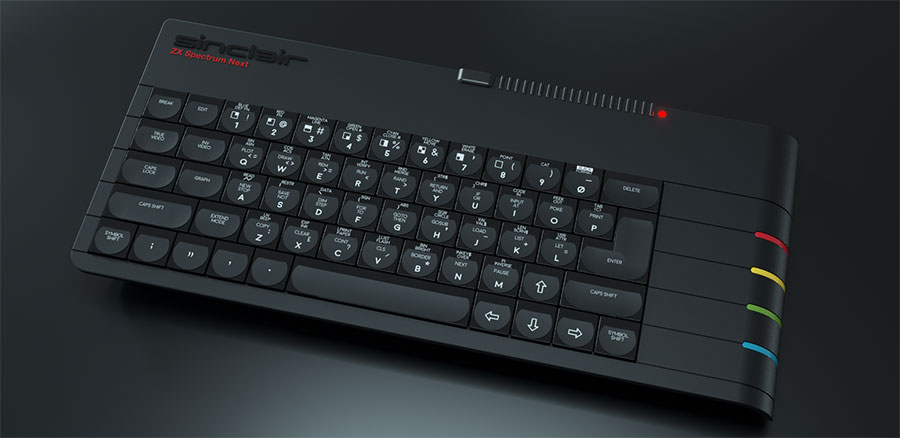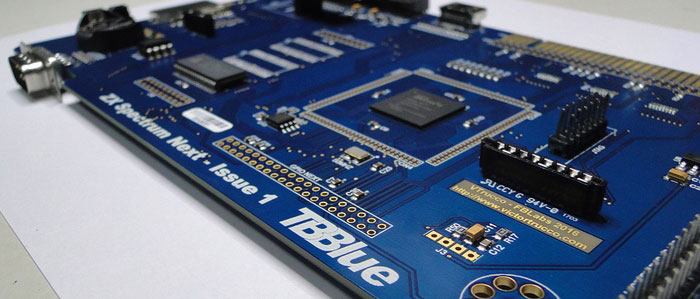ZX Spectrum Next
Sinclair ZX Spectrum Next is a modern 8-bit home computer, backwards compatible with the ZX Spectrum both in software and hardware, but also featuring enhanced capabilities due to it being powered by FPGA technology. It is intended to appeal to retro-computing enthusiasts and also to “encourage a new generation of bedroom coders”, according to project member Jim Bagley.

Despite the name, the machine is not directly affiliated with Sinclair Research Ltd., Sir Clive Sinclair or the current owner of the trademarks, Sky Group. Instead, the license to use the “Sinclair” name and “ZX Spectrum” trademark was granted to SpecNext Limited by Sky Group in exchange for a charitable donation to the Royal National Institute of Blind People.
The Next started life in 2010 in Brazil, as a variant of the TK95 Spectrum clone by Brazilian electronics manufacturer Microdigital. In 2016 Victor Trucco and Fabio Belavenuto announced the “TBBlue” firmware, named after the two creators and the color of the solder mask used on the motherboard that give it this blue color, instead of the traditional green that everyone is used to see. The unit is a bare circuit board implementation of the product for advanced hobbyists.

With the help of Henrique Olifiers the duo wanted to export the TBBlue board to the UK, the ZX Spectrum’s original home and place where it’s most cherished by retro computing users, having received moderate success with Brazilian fans.
The Next, which is based on TBBlue, was first announced as a distinct product in 2016 after the participation of original Spectrum industrial designer Rick Dickinson was secured to work on the design of the case/keyboard of the unit. Having worked with Sir Clive Sinclair on the early Spectrum designs, he was the right name to develop the look of the new unit.
Although initially intended to use the original ZX Spectrum’s Z80 chip, the design was altered to use the Xilinx Spartan-6 FPGA, to allow “hardware sprites, scrolling, and other advanced features to be incorporated within the machine itself”. FPGA allows for the Spectrum Next do things never imagined before, and made possible the creation of new games for the Next you can download from the project’s website.
A Kickstarter crowdfunding campaign was launched January 2017 with an initial funding goal of £250,000. At the end of the campaign 3,113 backers pledged £723,390, a huge and to a certain extent, unexpected success. However, while the campaign was successful in creating a significant user base for the new platform, it wasn’t a commercial success. Due to what campaign creators call “bad tax advice” the production of the machines ended up causing costs instead of revenue to the creators. Regardless of the issues, the Next was delivered to its backers on March 2020 and fulfilled every single promise it made, and more. The quality of the unit was touted by many British YouTubers and Spectrum aficionados.
With the experience gained on the first run, a second Kickstarter launched on August, 11th 2020 at 21:00 BST and reached 100% funding (£250,000) within six minutes allegedly. The campaign reached 400% funding (£1,000,000) only 3 days later, and 600% funding (£1,500,000) on September 7th, 2020, merely 3 days before the closing of the campaign on September 10th, 2020 with £1,847,106 pledged (738% funding).
The units for the second crowdfunding campaign is expected to be shipped to backers by mid to late 2021, unless unexpected delays happens. However, even with this huge success, Henrique Olifiers declared that there will not be a 3rd campaign, nor the ZX Spectrum Next will go into regular production, so if you’ve got one, lucky you. If you did not, you’ll need to look for something else. They even offered some limited pre-orders on their online store on November, 2020, but those were gone quickly.
This is the major let down about this fantastic project, probably one of the most successful computer crowdfunding projects of all time, but that is pretty much done now. You can’t just go on Amazon and purchase one of those at MSRP, nor on the specialized computer stores, in a similar scenario with the Analogue products, the only difference is that Analogue products are not crowdfunded, but they exist in very limited stock the same way as the Spectrum Next.
Resources
Kickstarter Crowdfunding Campaigns
– First Campaign 2017
– Second Campaign 2020
Official Website
– specnext.com
